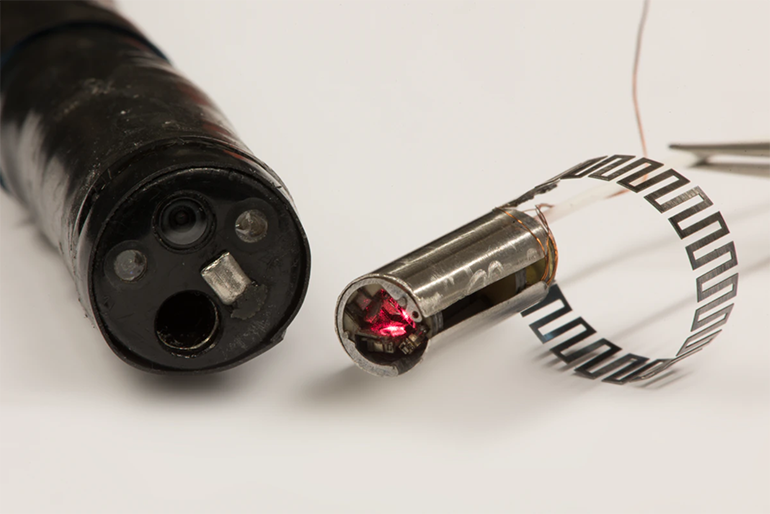

Applying an energy source, such as a laser, to cut through or cauterize tissue is already widely used in external surgeries, such as laser eye surgery, but using this technology safely and accurately during minimally invasive internal procedures is difficult. Current endoscopic technology does not permit lasers to be steered and manipulated with sufficient precision.

Now researchers at the Harvard Wyss Institute have developed a new technique to accurately steer a laser beam at the end of an endoscope for minimally invasive laser surgery. The approach relies on three small mirrors that move within a tiny cylinder to accurately steer the laser path within a significant range of motion. The entire device resides within the working channel of an endoscope, allowing a surgeon to precisely control laser movement inside the body.
“To enable minimally invasive laser surgery inside the body, we devised a micro-robotic approach that allows us to precisely direct a laser beam at small target sites in complex patterns within an anatomical area of interest,” said Peter York, a researcher involved in the study. “With its large range of articulation, minimal footprint, and fast and precise action, this laser-steering end-effector has great potential to enhance surgical capabilities simply by being added to existing endoscopic devices in a plug-and-play fashion.”
The system uses a series of small mirrors that can be articulated to control the path of the laser through the device, which it enters through an optical fiber. The major challenge was creating a working mechanism within such a small space – the cylinder used to house the components is approximately the diameter of a drinking straw.

“We found that for steering and re-directing the laser beam, a configuration of three small mirrors that can rapidly rotate with respect to one another in a small ‘galvanometer’ design provided a sweet spot for our miniaturization effort,” said Rut Peña, another researcher involved in the project. “To get there, we leveraged methods from our microfabrication arsenal in which modular components are laminated step-wise onto a superstructure on the millimeter scale – a highly effective fabrication process when it comes to iterating on designs quickly in search of an optimum, and delivering a robust strategy for mass-manufacturing a successful product.”
more recommended stories
 Safer Allogeneic Stem Cell Transplants with Treg Therapy
Safer Allogeneic Stem Cell Transplants with Treg TherapyA new preclinical study from the.
 Autoimmune Disorders: ADA2 as a Therapeutic Target
Autoimmune Disorders: ADA2 as a Therapeutic TargetAdenosine deaminase 2 (ADA2) has emerged.
 Kaempferol: A Breakthrough in Allergy Management
Kaempferol: A Breakthrough in Allergy ManagementKaempferol, a dietary flavonoid found in.
 Early Milk Cereal Drinks May Spur Infant Weight Gain
Early Milk Cereal Drinks May Spur Infant Weight GainNew research published in Acta Paediatrica.
 TaVNS: A Breakthrough for Chronic Insomnia Treatment
TaVNS: A Breakthrough for Chronic Insomnia TreatmentA recent study conducted by the.
 First-of-Its-Kind Gene-Edited Pig Kidney: Towana’s New Life
First-of-Its-Kind Gene-Edited Pig Kidney: Towana’s New LifeSurgeons at NYU Langone Health have.
 Just-in-Time Training Improves Success & Patient Safety
Just-in-Time Training Improves Success & Patient SafetyA study published in The BMJ.
 ChatGPT Excels in Medical Summaries, Lacks Field-Specific Relevance
ChatGPT Excels in Medical Summaries, Lacks Field-Specific RelevanceIn a recent study published in.
 Study finds automated decision minimizes high-risk medicine combinations in ICU patients
Study finds automated decision minimizes high-risk medicine combinations in ICU patientsA multicenter study coordinated by Amsterdam.
 Study Discovers Connection Between Omicron Infection and Brain Structure Changes in Men
Study Discovers Connection Between Omicron Infection and Brain Structure Changes in MenA recent study in the JAMA.

Leave a Comment